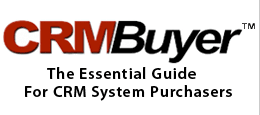Thanks for the overwhelming response to last week’s post, “Why CRM Works.” It was surprising and gratifying that so many people read and tweeted about it given its length — almost double my usual contribution. Since it was based on Daniel Kahneman’s groundbreaking work, I give all the credit to him and his great career in trying to understand how we think.
One comment came in that I thought would make a good jumping off point for this week. Barry Dalton wrote:
“I’m confused as to how the Sales VP involvement metric is a System 1 decision point. If it is based on quantifiable evidence, derived through an analytical method, wouldn’t that be a system 2 decision? Or, is it the fact that, once the analytics proves the assumption to be true, it no longer requires analysis at each decision point, so therefore moves from system 2 to system 1 because you’re now accepting it as fact without additional analysis?”
Dalton answered his own question in his second interpretation. Once the thinking has already occurred, the result is a real metric that with use becomes a KPI or key performance indicator. In my response to him I said that the great thing about KPIs is that they cross over from System 2 into System 1 land. Everyone doesn’t have to do the same thinking and re-discovery, they only need to use the KPI as a valid new measure.
The best analogy I can come up with for KPIs like this is of an enzyme, a biological catalyst that makes reactions happen faster or require less energy than the reaction would require under un-catalyzed conditions. Ultimately that’s what we all want — ways to do the right thing without having to cogitate over it incessantly.
System 1 and System 2 are really just the beginning of the story though and the value of understanding Kahneman’s work is that it helps us identify when we might be slipping into System 1 thinking even when our limited System 1’s might be out of their depth. According to Kahneman, System 2 is powerful but “lazy” in that our brains would prefer to rely on a more or less automatic System 1 response than engage System 2.
You can see this in real life. System 1 is rarely stumped for an answer and often when confronted by a System 2 problem we might simply opt to change the subject. So, for instance, you might find yourself or someone you are speaking with answering the question they wish they’d been asked rather than the one they don’t have an adequate answer for. This happens all the time. No wonder we can sometimes seem to be talking at cross-purposes!
There is a practical CRM application here too and I’ve been waiting for weeks to set it up. So much of conventional sales and marketing is mired in System 1 activity. Customers have short attention spans and we have relatively small windows to try to get a new idea (our products and services) into them. If an idea seems the least bit foreign there is a good chance it will be rejected by System 1.
The solution is to attempt to reach a customer’s System 2 thinking apparatus. That’s what we do in a conventional sales process in which a sales person builds up credibility and trust with a customer so that he or she can educate the customer through System 2. It’s often said in sales that people make logical decisions (System 2) for emotional reasons (System 1) and this is my interpretation of how and why.
But how do you achieve this today? Companies trying to cut costs put products into other channels, for example or they develop freemium models that enable customers to educate themselves. Unfortunately, the revenue potential of a freemium is often bupkus. That’s where social media is so valuable.
If we believe the research, then people have greater trust in “someone like me” when it comes to understanding a product or service. Social networks and communities are places where people feel secure enough to expose the System 2 side of their thinking and to receive other people’s ideas. And that’s why social media is so important to the future of business. If you can use social techniques to reach System 2 you can catalyze your business processes. But there’s a cost associated with this.
The new role of the enterprise is to ensure that in its social space people are respected for their ideas and that only truth is allowed to be broadcast. That’s also why potentially embarrassing or negative information about the vendor is allowed to circulate. Nobody’s perfect and trying to suppress truth is how to engender dis-trust.
This is all very interesting to me and another question worth exploring is how social media can really succeed inside the enterprise. Consider this: if social media has the potential to make us work or work harder and our brains love to be in System 1 mode, how do we use social constructs to get people to willingly engage their System 2’s inside the enterprise?
That’s not an idle question as many organizations are attempting to cross a chasm right now from old style thinking (and business) to become new and modern social enterprises. Let’s tackle that one next time.
 CRM Magazine/destinationCRM.com
CRM Magazine/destinationCRM.com CRMBuyer
CRMBuyer ForecastingClouds
ForecastingClouds InSide CRM
InSide CRM SearchCRM
SearchCRM Animal Spirits
Animal Spirits Butterfly Economics, Paul Ormerod
Butterfly Economics, Paul Ormerod Competing on Analytics: The New Science of Winning
Competing on Analytics: The New Science of Winning Crowdsourcing
Crowdsourcing Dealing with Darwin, Geoffrey Moore
Dealing with Darwin, Geoffrey Moore Hello, Ladies! Dispatches from the Social CRM Frontier
Hello, Ladies! Dispatches from the Social CRM Frontier Origin of Wealth: Evolution, Complexity, and the Radical Remaking of Economics
Origin of Wealth: Evolution, Complexity, and the Radical Remaking of Economics Strategy and the Fat Smoker
Strategy and the Fat Smoker The Black Swan
The Black Swan The Wisdom of Crowds
The Wisdom of Crowds Twitter
Twitter Gary Lemke over at
Gary Lemke over at